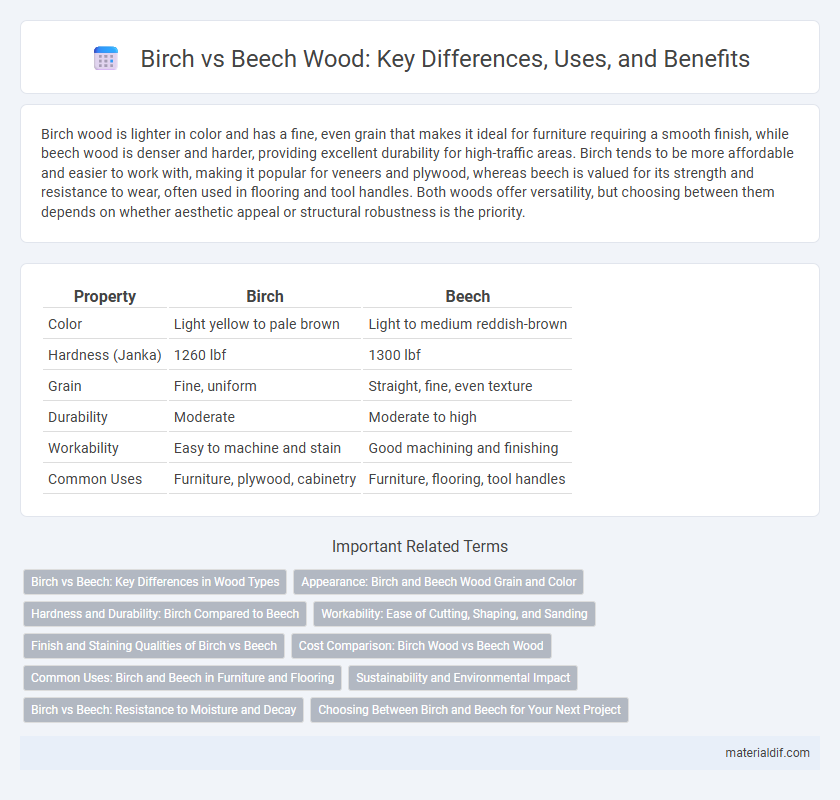Birch wood is lighter in color and has a fine, even grain that makes it ideal for furniture requiring a smooth finish, while beech wood is denser and harder, providing excellent durability for high-traffic areas. Birch tends to be more affordable and easier to work with, making it popular for veneers and plywood, whereas beech is valued for its strength and resistance to wear, often used in flooring and tool handles. Both woods offer versatility, but choosing between them depends on whether aesthetic appeal or structural robustness is the priority.
Table of Comparison
| Property | Birch | Beech |
|---|---|---|
| Color | Light yellow to pale brown | Light to medium reddish-brown |
| Hardness (Janka) | 1260 lbf | 1300 lbf |
| Grain | Fine, uniform | Straight, fine, even texture |
| Durability | Moderate | Moderate to high |
| Workability | Easy to machine and stain | Good machining and finishing |
| Common Uses | Furniture, plywood, cabinetry | Furniture, flooring, tool handles |
Birch vs Beech: Key Differences in Wood Types
Birch wood features a fine grain with a pale cream color and is known for its strength and resistance to shock, making it ideal for furniture and plywood. Beech wood has a tighter, more uniform grain with a pinkish hue and offers superior hardness and wear resistance, commonly used in flooring and tool handles. While birch tends to be easier to work with due to its slightly softer nature, beech provides greater durability and stability in high-traffic applications.
Appearance: Birch and Beech Wood Grain and Color
Birch wood features a fine, uniform grain with a pale cream to light yellow color, often exhibiting subtle reddish hues and a smooth texture that enhances its bright and clean aesthetic. Beech wood displays a straight grain with a slightly coarse texture, showing a warm, light to medium reddish-brown color that deepens over time, offering a more robust and traditional appearance. The contrast between birch's lighter, more uniform look and beech's richer, warmer tones makes each suitable for different interior design styles and woodworking projects.
Hardness and Durability: Birch Compared to Beech
Birch wood exhibits a Janka hardness rating of approximately 1260 lbf, making it moderately hard and suitable for flooring and furniture that require resilience. In comparison, Beech wood has a higher Janka hardness around 1300 lbf, indicating greater resistance to dents and wear. Birch offers good durability but Beech's tighter grain and higher density contribute to superior longevity in high-traffic applications.
Workability: Ease of Cutting, Shaping, and Sanding
Birch wood is known for its fine grain and smooth texture, making it easier to cut, shape, and sand compared to beech. Beech wood, while dense and hard, can be more challenging to work with due to its tighter grain and higher tannin content. Both woods respond well to hand and machine tools, but birch generally offers superior workability for detailed woodworking projects.
Finish and Staining Qualities of Birch vs Beech
Birch wood offers a smooth, fine grain that absorbs stains evenly, resulting in a consistent and bright finish ideal for vibrant colors. Beech wood features a tighter, closed grain which can make staining more challenging, often requiring pre-treatment to avoid blotchiness and achieve a uniform tone. Both woods respond well to clear finishes, but birch tends to highlight grain patterns better, while beech provides a more muted, subtle appearance.
Cost Comparison: Birch Wood vs Beech Wood
Birch wood generally costs less than beech wood due to its wider availability and faster growth rate, making it a budget-friendly option for furniture and cabinetry. Beech wood is typically more expensive because of its durability, hardness, and fine grain, which require longer maturation periods and careful processing. Choosing between birch and beech wood depends on balancing cost efficiency with desired strength and aesthetic qualities.
Common Uses: Birch and Beech in Furniture and Flooring
Birch wood is commonly used in furniture making due to its fine grain and pale color, making it ideal for modern and Scandinavian designs, while its durability also suits flooring applications. Beech wood, known for its hardness and wear resistance, is frequently chosen for flooring in high-traffic areas and traditional furniture such as chairs and tables that require robust construction. Both woods offer excellent workability, but birch provides a smoother finish, whereas beech is valued for its strength and ability to withstand heavy use.
Sustainability and Environmental Impact
Birch wood is highly sustainable due to its rapid growth rate and widespread availability, making it an eco-friendly choice for furniture and flooring. Beech wood also offers sustainability benefits, with strong regeneration capabilities and a lower carbon footprint during harvesting and processing. Both species support biodiversity and forest health when sourced from responsibly managed forests certified by organizations like FSC or PEFC.
Birch vs Beech: Resistance to Moisture and Decay
Birch wood has moderate resistance to moisture but is more prone to decay compared to beech, making it less suitable for outdoor use or damp environments. Beech wood offers better resistance to moisture and natural decay, which enhances its durability in humid conditions. This difference is critical when selecting wood for applications requiring longevity and stability in moist or variable environments.
Choosing Between Birch and Beech for Your Next Project
Birch wood offers a pale, fine-grained texture that is ideal for smooth finishes and detailed woodworking, making it suitable for furniture and cabinetry requiring a sleek appearance. Beech, known for its hardness and uniform grain, provides exceptional durability and resistance to wear, perfect for flooring, tool handles, and robust furniture. When choosing between birch and beech, prioritize the project's need for aesthetics versus strength, as birch excels in visual appeal and workability, while beech delivers superior hardness and longevity.
Birch vs Beech Infographic

 materialdif.com
materialdif.com